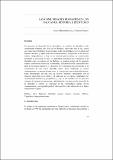Files in this item
Roma communities on the Balkans : history and identities
Item metadata
| dc.contributor.author | Marushiakova-Popova, Elena Andreevna | |
| dc.contributor.author | Popov, Veselin | |
| dc.date.accessioned | 2018-07-26T11:30:05Z | |
| dc.date.available | 2018-07-26T11:30:05Z | |
| dc.date.issued | 2018-07 | |
| dc.identifier | 253304106 | |
| dc.identifier | fc90ffc8-d364-4089-a785-06f68b0c7ee2 | |
| dc.identifier.citation | Marushiakova-Popova , E A & Popov , V 2018 , ' Roma communities on the Balkans : history and identities ' , Balkania , vol. 2017 , no. 8 , pp. 15-36 . < http://www.balkania.es/wp-content/uploads/2015/12/Elena-Marushiakova-Vesselin-Popov-SPA.pdf > | en |
| dc.identifier.issn | 2172-5535 | |
| dc.identifier.other | ORCID: /0000-0001-5333-2330/work/46939698 | |
| dc.identifier.other | ORCID: /0000-0002-6565-8730/work/46939706 | |
| dc.identifier.uri | https://hdl.handle.net/10023/15711 | |
| dc.description | Funding: ‘RomaInterbellum. Roma Civic Emancipation between the Two World Wars’ which has received funding from the European Research Council (ERC) under the European Union’s Horizon 2020 research and innovation programme (Grant agreement No 694656). | en |
| dc.description.abstract | The processes of identity development and identity changes in the Roma communities living in the Balkans observed nowadays have their old historical roots. These processes are documented as early as in the time of the Ottoman Empire, they acquired new dimensions and directions in the new independent states, and today in the conditions of post-socialism, their controversial development is activated once again. The main trends in the identity development among the Roma in the Balkans can be summarized as follows: a) internal development of the community; b) development of the community as part of the respective nation; c) development of preferred ethnic identity; d) the construction of a new ethnic identity. These trends are constantly intersecting, moving from one to another, sometimes even going in reverse direction. They are influenced by a number of "external" factors related to the specific situation in the region and in the individual countries framed by historical and geopolitical circumstances, and nowadays also by the common processes of pan-European integration and globalization. The processes of identity development and identity change in the Roma communities are constantly flowing and it is impossible to predict now which direction they will acquire in more near or distant future. | |
| dc.format.extent | 22 | |
| dc.format.extent | 363327 | |
| dc.format.extent | 341983 | |
| dc.language.iso | eng | |
| dc.relation.ispartof | Balkania | en |
| dc.subject | Balkans | en |
| dc.subject | Identity | en |
| dc.subject | Roma | en |
| dc.subject | Ottoman Empire | en |
| dc.subject | Albania | en |
| dc.subject | Yogoslavia | en |
| dc.subject | European integration | en |
| dc.subject | DR Balkan Peninsula | en |
| dc.subject | T-NDAS | en |
| dc.subject.lcc | DR | en |
| dc.title | Roma communities on the Balkans : history and identities | en |
| dc.type | Journal article | en |
| dc.contributor.sponsor | European Research Council | en |
| dc.contributor.sponsor | European Research Council | en |
| dc.contributor.institution | University of St Andrews. School of History | en |
| dc.description.status | Peer reviewed | en |
| dc.identifier.url | http://www.balkania.es/inicio | en |
| dc.identifier.url | http://www.balkania.es/wp-content/uploads/2015/12/Elena-Marushiakova-Vesselin-Popov-SPA.pdf | en |
| dc.identifier.grantnumber | 694656 | en |
| dc.identifier.grantnumber | 694656 | en |
This item appears in the following Collection(s)
Items in the St Andrews Research Repository are protected by copyright, with all rights reserved, unless otherwise indicated.


